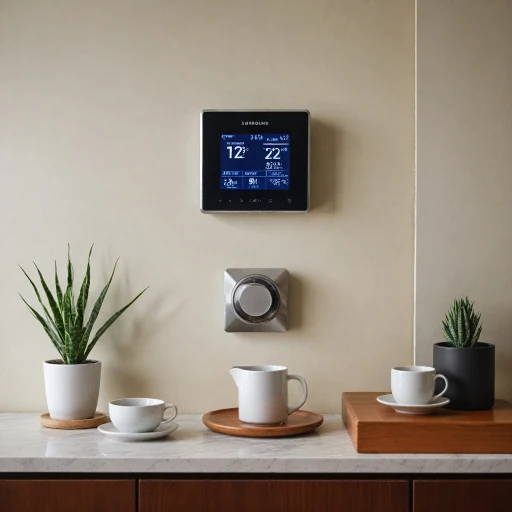What is a Smart Thermostat?
Exploring the Basics of Smart Thermostats
Smart thermostats are a cutting-edge solution for managing your home's temperature with greater efficiency and convenience. Unlike traditional thermostats, these advanced devices connect to your home's Wi-Fi network, enabling you to control your heating and cooling systems remotely through a smartphone app or web portal.
A variety of smart thermostats are available on the market, ranging from basic models to sophisticated units like the Google Nest. These devices offer features such as programmable settings, learning capabilities, and integration with other smart home devices. Such functionalities can lead to significant energy savings, making them an attractive option for homeowners looking to optimize their HVAC systems.
Additionally, smart thermostats provide real-time feedback on your energy usage, helping you make informed decisions about your consumption habits. With potential savings on your energy bills, the initial cost of purchasing and installing these devices may be offset over time.
However, users interested in installing a smart thermostat should be aware of several factors that can influence the overall cost. This includes the complexity of the installation process, for instance, whether your existing setup requires thermostat replacement or simply a thermostat installation. In some cases, certain models might necessitate additional work to ensure compatibility with older HVAC systems.
If you're curious about the role of specific components in smart thermostats, such as the blue wire, you might find this
comprehensive guide helpful as it delves into the intricacies of wiring and its impact on installation and operation.
Investing in a smart thermostat is a smart choice for those looking to enhance the efficiency of their heating and cooling systems while also benefiting from the convenience of modern technology.
Factors Influencing Installation Costs
Understanding the Price Tags of Smart Thermostat Installation
While the allure of smart thermostats is undeniable, understanding the factors influencing their installation costs is vital for homeowners making the transition. Several key elements determine the amount you might spend on installing a system that will ultimately control your home's heating and cooling more efficiently.
- Type of HVAC System: The complexity of your existing HVAC system plays a significant role in determining installation costs. Smart thermostats can integrate with a range of systems, but those with more sophisticated configurations may require additional spending.
- Wiring Requirements: Many thermostats and smart units may require low voltage wiring, which could involve additional labor if your current setup lacks the necessary connections. This can increase the costs of installing a smart thermostat.
- Professional vs. DIY Installation: Opting for professional installation from skilled thermostat installers can increase the costs; however, it ensures proper setup and operation, potentially avoiding future issues. Alternatively, homeowner installation may save money but risk errors.
- Existing Unit Replacement: If you're swapping out an older, non-programmable model for a modern smart thermostat, consider the labor costs associated with replacing the unit.
- Brand and Model: Popular models like the Nest or Google Nest have varying price tags which can influence the overall cost of installation. A costlier thermostat does not necessarily mean more expensive installation fees, but brand complexity can play a part.
For those considering the nuances of smart thermostat costs, a more detailed examination can be found in
A Comprehensive Guide to Installing the Honeywell T6 Pro Thermostat.
Ultimately, understanding these factors helps in planning your budget effectively and ensures you select the right system and installation method suitable for your needs. As technology advances, smart thermostats represent a significant step towards enhanced energy management and reduced utility expenses. Understanding the cost components and making informed choices can make the transition smoother and more cost-effective.
DIY vs. Professional Installation
DIY Installation vs. Hiring a Professional
When it comes to installing a smart thermostat, homeowners are often faced with the choice between handling the installation themselves or hiring a professional. Both options have their own set of pros and cons, which can significantly affect the overall installation costs.
DIY Installation
For the DIY enthusiasts, installing a thermostat on their own may seem like an attractive option. It can potentially save on labor costs that come with hiring a professional installer. Some modern thermostats, such as Nest and other programmable thermostats, come with comprehensive installation guides and are designed to be user-friendly.
- Advantages: Cost-saving potential, immediate installation, and a sense of personal accomplishment.
- Disadvantages: Risks of improper installation, especially if your HVAC system or wiring is complex. Lack of expertise in handling low voltage systems could lead to costly mistakes.
Before proceeding with a DIY approach, one should consider how comfortable they are with working on electrical components and whether they understand the
essential wiring diagrams.
Professional Installation
Opting for professional installation ensures that experts handle the task, thus minimizing the chances of error. Professional installers are familiar with various types of HVAC systems and possess the skills to install smart thermostats efficiently.
- Advantages: Assurance of proper installation, reduced risk of damage, access to professional advice, and the installation is usually covered by warranties.
- Disadvantages: Higher installation costs, scheduling appointments can take time.
For those who prefer peace of mind and certainty in the thermostat installation process, professional services are the way to go. Moreover, professionally installed systems can lead to enhanced energy efficiency, which aids in recovering the initial cost over time.
So, which option will be most cost-effective for your situation? It largely depends on your comfort with technology, the complexity of your existing HVAC system, and your willingness to pay for professional labor. It’s also important to take into account potential long-term savings and benefits that come with efficient temperature control.
Understanding both approaches thoroughly can help you make an informed decision. For further guidance, you can explore expert tips on
choosing the right installation method for your smart home.
Potential Savings and Benefits
Unlocking the Financial Benefits of Smart Thermostats
Smart thermostats have become a popular choice for homeowners due to their potential to deliver substantial energy savings and a range of other benefits. While the initial cost of installing a smart thermostat might seem high, the long-term savings often outweigh these initial expenses.
Firstly, a smart thermostat can optimize your HVAC system by learning your temperature preferences and automatically adjusting the heating and cooling settings. This results in reduced energy consumption as the system operates only when necessary, thus saving on energy bills.
In addition, many utility companies offer rebates for homeowners who install energy-efficient devices like smart thermostats. These incentives can significantly reduce the average cost and installation cost of new units.
Moreover, the ability to control the thermostat remotely via a smartphone app means you can make adjustments on-the-go. This level of control helps to prevent unnecessary energy use when you're away from home.
The long-term financial benefit of installing smart thermostats comes down to reducing wear and tear on your HVAC system. By minimizing the frequency of running heating and cooling cycles, you can extend the lifespan of your HVAC systems, which translates to fewer repair costs and a lower need for early replacement.
While the upfront thermostat installation costs might be a consideration, smart thermostats' energy efficiency and ease in managing your home's environment present numerous monetary advantages for keen homeowners aiming to cut electricity expenses and improve their carbon footprint.
Common Challenges and Solutions
Facing Installation Obstacles
When installing a smart thermostat, homeowners may encounter a few common challenges. Being aware of these potential issues can help mitigate them effectively.
Wiring Complexities
One of the most frequent hurdles is dealing with wiring. Many older homes are equipped with low voltage HVAC systems, which might require additional wiring to support new smart thermostats. If you're replacing an older unit with a new programmable thermostat, you may face incompatibility issues related to the wiring system. It's crucial to check the existing wiring and seek advice from thermostat installers if there's any confusion.
Compatibility with HVAC Systems
Another concern can be ensuring that the thermostat installation aligns with your existing HVAC system. Not all heating and cooling systems are compatible with every type of smart thermostat available on the market. Conduct thorough research on which thermostats are most suitable for your specific type of HVAC system.
Network Connectivity Issues
Given that smart thermostats rely on Wi-Fi connections, network issues can impede the performance. It's essential to ensure a stable internet connection for the thermostat to function smoothly. In rural areas or places with weak internet signals, this could be an area that needs additional attention and possible upgrades.
Dealing with Cost Concerns
The cost of installation, both in terms of time and money, can be a barrier for some homeowners. Weighing the pros and cons of professional installation versus a DIY approach can help manage overall costs. Remember, professional installation might cost more initially but can save potential mishaps in wiring or installation errors that could lead to higher repair costs down the line.
Understanding these potential challenges in smart thermostat installation can pave the way for a smoother process, ensuring your home benefits fully from improved energy efficiency.
Tips for Choosing the Right Smart Thermostat
Smart Thermostat Selection Tips
When installing smart thermostats in your home, choosing the right unit is crucial. Here are several tips to guide you:
- Identify Your HVAC System: Not all smart thermostats are compatible with every HVAC system. Before purchasing, confirm whether your heating and cooling units are compatible with the smart thermostat you are considering.
- Wiring Requirements: Different thermostats need different wiring setups. Determine if your current wiring supports smart thermostats or if you'll need updates. Some models require a C-wire to provide continuous power.
- Features Matter: Assess which features are essential for you, such as remote control via smartphone, learning capabilities, energy reports, and the ability to integrate with other smart home devices. Brands like Google Nest offer advanced features.
- Budget Considerations: While installation costs and the average cost of the units themselves can vary, investing in a quality smart thermostat can lead to substantial energy savings. Weigh the initial cost against potential savings on energy bills.
- Professional Installation: If you're unsure of your electrical skills or the complexity of the wiring, it's a good idea to consider professional installation. It can minimize errors and ensure that the unit functions efficiently.
- Read Reviews and Ratings: Check customer feedback on different models to learn about real-world performance and compatibility issues you might face.
With careful consideration of these factors, you can select a smart thermostat that will serve your home's heating and cooling needs efficiently, providing comfort and cost savings.

